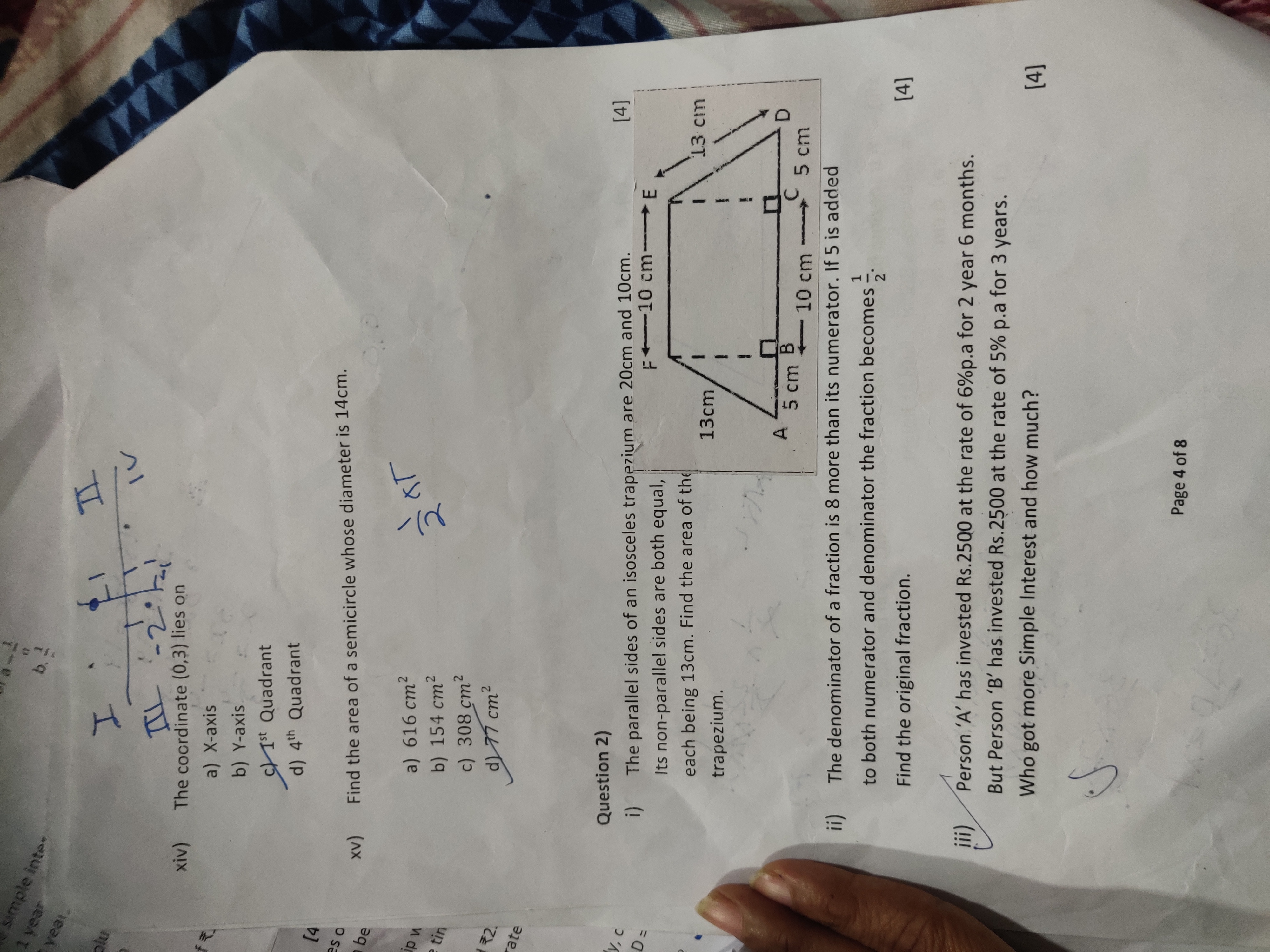xiv) The coordinate (0,3) lies on which axis or quadrant? xv) Find the area of a semicircle whose diameter is 14cm. 2i) The parallel sides of an isosceles trapezium are 20cm and 10... xiv) The coordinate (0,3) lies on which axis or quadrant? xv) Find the area of a semicircle whose diameter is 14cm. 2i) The parallel sides of an isosceles trapezium are 20cm and 10cm. Its non-parallel sides are both equal, each being 13cm. Find the area of the trapezium. 2ii) The denominator of a fraction is 8 more than its numerator. If 5 is added to both numerator and denominator the fraction becomes 1/2. Find the original fraction. 2iii) Person 'A' has invested Rs.2500 at the rate of 6% p.a for 2 year 6 months. Person 'B' has invested Rs.2500 at the rate of 5% p.a for 3 years. Who got more Simple Interest and how much?

Understand the Problem
This appears to be an image of mathematics questions, let's break down each question.
Question xiv: Asks which axis or quadrant the coordinate lies on. Question xv: Asks to find the area of a semicircle given its diameter. Question 2i: Asks to find the area of an isosceles trapezium given the lengths of its parallel and non-parallel sides. Question 2ii: Asks to find the original fraction given that the denominator is 8 more than the numerator, and adding 5 to both the numerator and denominator results in the fraction becoming 1/2. Question 2iii: Asks us to determine who earned more simple interest between persons 'A' and 'B', where person A invested Rs. 2500 at 6% per annum for 2.5 years, and person B invested Rs. 2500 at 5% per annum for 3 years, also it wants to know the exact difference in said interest.
Answer
xiv) Y-axis xv) $77 \text{ cm}^2$ i) $180 \text{ cm}^2$ ii) $\frac{3}{11}$ iii) Rs. 0
Answer for screen readers
xiv) b) Y-axis xv) d) 77 cm² i) 180 cm$^2$ ii) $\frac{3}{11}$ iii) Both earned the same simple interest. The difference is Rs. 0.
Steps to Solve
- Question xiv: Determine which axis/quadrant the point (0,3) lies on.
Since the x-coordinate is 0, the point lies on the y-axis.
- Question xv: Calculate the area of a semicircle with diameter 14cm.
The radius of the semicircle is half of the diameter, so $r = \frac{14}{2} = 7$ cm. The area of a full circle is $A = \pi r^2$. The area of a semicircle is half of the area of a full circle, so $A_{semicircle} = \frac{1}{2} \pi r^2 = \frac{1}{2} \pi (7^2) = \frac{1}{2} \pi (49) = \frac{49\pi}{2}$.
Using $\pi = \frac{22}{7}$, we have $A_{semicircle} = \frac{49}{2} \times \frac{22}{7} = \frac{7 \times 22}{2} = 7 \times 11 = 77$ cm$^2$.
- Question 2i: Find the area of an isosceles trapezium.
The parallel sides are 20 cm and 10 cm. The non-parallel sides are 13 cm each.
To find the area, we need the height ($h$). Drop perpendiculars from the shorter parallel side to the longer one. This divides the trapezium into a rectangle and two congruent right triangles. The length of the base of each right triangle is $\frac{20 - 10}{2} = \frac{10}{2} = 5$ cm.
Using the Pythagorean theorem for one of the right triangles: $5^2 + h^2 = 13^2$, so $25 + h^2 = 169$. This gives $h^2 = 169 - 25 = 144$, and thus $h = \sqrt{144} = 12$ cm.
The area of the trapezium is given by: $A = \frac{1}{2} (a + b) h = \frac{1}{2} (20 + 10) \times 12 = \frac{1}{2} (30) \times 12 = 15 \times 12 = 180$ cm$^2$.
- Question 2ii: Find the original fraction.
Let the numerator be $x$. The denominator is $x + 8$. The original fraction is $\frac{x}{x+8}$. If we add 5 to both the numerator and denominator, the fraction becomes $\frac{x+5}{x+8+5} = \frac{x+5}{x+13}$, which is equal to $\frac{1}{2}$. So, $\frac{x+5}{x+13} = \frac{1}{2}$.
Cross-multiplying, we get $2(x+5) = x+13$, so $2x + 10 = x + 13$. Then $2x - x = 13 - 10$, which gives $x = 3$.
The original fraction is $\frac{3}{3+8} = \frac{3}{11}$.
- Question 2iii: Determine who earned more simple interest and by how much.
For person A: Principal ($P_A$) = Rs. 2500 Rate ($R_A$) = 6% per annum Time ($T_A$) = 2.5 years Simple Interest ($SI_A$) = $\frac{P_A \times R_A \times T_A}{100} = \frac{2500 \times 6 \times 2.5}{100} = 25 \times 6 \times 2.5 = 150 \times 2.5 = 375$ Rs.
For person B: Principal ($P_B$) = Rs. 2500 Rate ($R_B$) = 5% per annum Time ($T_B$) = 3 years Simple Interest ($SI_B$) = $\frac{P_B \times R_B \times T_B}{100} = \frac{2500 \times 5 \times 3}{100} = 25 \times 5 \times 3 = 125 \times 3 = 375$ Rs.
Both earned the same simple interest, Rs. 375. The difference is Rs. $375 - 375 = 0$.
xiv) b) Y-axis xv) d) 77 cm² i) 180 cm$^2$ ii) $\frac{3}{11}$ iii) Both earned the same simple interest. The difference is Rs. 0.
More Information
Simple interest represents the earnings on a principal investment. The simple interest is calculated using the formula $SI = \frac{PRT}{100}$, where P is the principal, R is the rate, and T is the time.
Tips
- For the semicircle area, forgetting to divide the circle area by 2.
- Errors in calculating height of the trapezium.
AI-generated content may contain errors. Please verify critical information